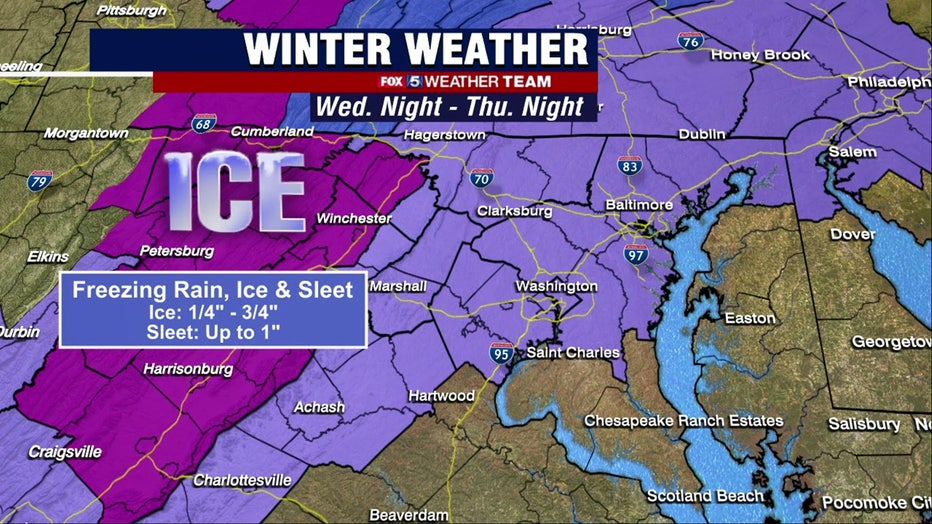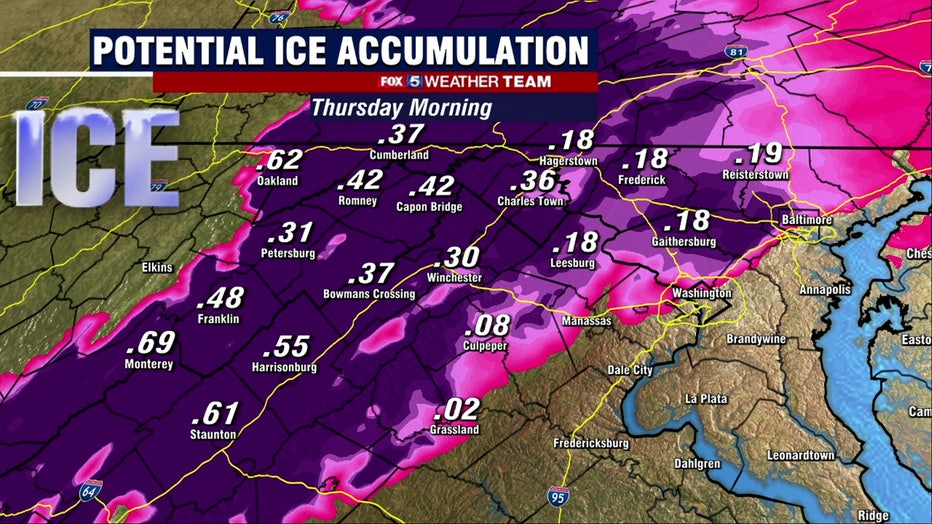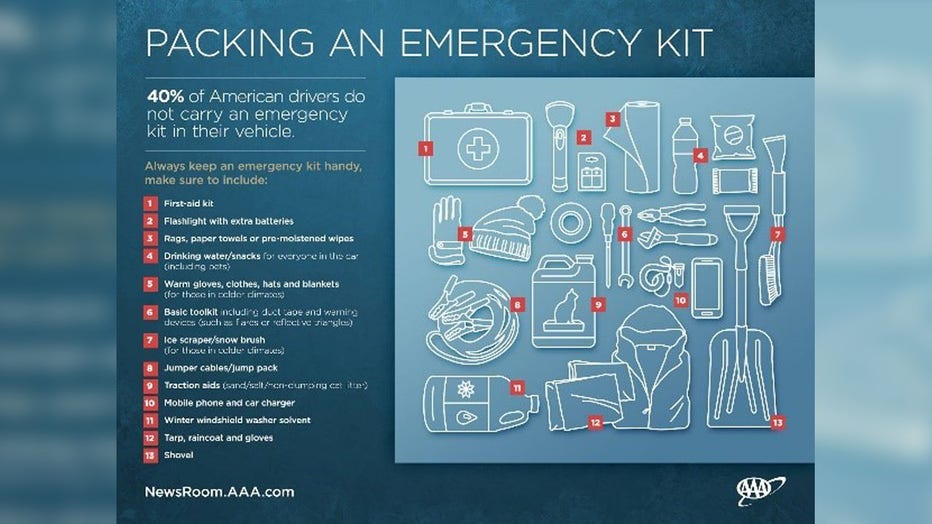An icy mess is expected across DC, Maryland, and Virginia on Thursday. Here's how you can prepare.
Freezing rain, ice early Thursday will change to rain quickly
FOX 5's Caitlin Roth has the latest on Thursday's freezing rain and icy forecast.
WASHINGTON - A winter storm system is expected to bring freezing rain, ice, and sleet to the D.C. region beginning early Thursday. Here's what to expect and how to stay safe.
FOX 5’s Tucker Barnes says an area of low pressure will push moisture into the D.C. region beginning sometime after 2 a.m. The rain that falls is expected to freeze on contact with the surface creating an icy mess on area roadways through the morning commute. This will likely be the first significant winter weather event of meteorological winter.

The freezing rain is expected to strike areas along the I-95 corridor and to the north and west of the city. Parts of southern Maryland and the Eastern Shore will likely see only rain.
By 9 a.m. Thursday, we should see a change to mostly rain in the immediate Washington, D.C. area with parts to the north and west transitioning to all rain by noon.

The storm is not expected to leave behind much ice in the District but places to the north and west could see a significant amount of ice accumulation. Barnes say as much as ¼ inch of ice could accumulate in areas like Leesburg, Hagerstown, and Winchester. Winter Weather Advisories and Ice Storm Warnings will be in effect for the region from late this evening through Thursday morning.
Preparations underway for DMV's first major winter storm of season
FOX 5's Jennifer Delgado visited Leesburg, Virginia to find out how officials there are preparing for a winter storm system that is expected to bring freezing rain, ice, and sleet to the D.C. region beginning early Thursday morning.
The storm should move out of the region by the afternoon hours, but commuters can expect a wet, soggy, and slippery day on the roadways with cold temperatures near 40 degrees.
Agencies in D.C., Maryland and Virginia have mobilized crews to prepare ahead of the storm. The Virginia Department of Transportation also warned drivers to use caution – especially those who will be out along the I-81 corridor, and in the Culpeper and Northern Virginia regions. Virginia officials also urged motorists to check the road conditions before leaving, allow extra time for travel, reduce speeds significantly, and to even reconsider travel plans and work remotely.
In January, a major snowstorm jammed traffic along a 50-mile stretch of Interstate 95 in Virginia leaving some drivers stranded in their vehicles overnight.

AAA
Being smart and staying prepared is the key to safety while driving in winter weather. Here are some tips to get prepared before you leave, to stay safe while driving, and to be ready if you do get stuck.
Crews prep for winter weather
Crews have been pretreating roads across the DMV ahead of expected icy conditions.
Packing an emergency kit before you hit the road:
- Abrasive material (sand, salt, cat litter) or traction mats
- Snow shovel
- Flashlight with extra batteries
- Window washer solvent
- Ice scraper with brush
- Jumper cables
- Extra warm clothing (gloves, hats, scarves), and blankets
- Warning devices (flares or triangles)
- Drinking water and non-perishable snacks for both human and pet passengers
- First-aid kit
- Basic toolkit (screwdrivers, pliers, adjustable wrench)
- Mobile phone, charger and power bank
Officials brace for DMV's first major winter storm of season
A winter storm system is expected to bring freezing rain, ice, and sleet to the D.C. region beginning early Thursday. FOX 5's Jennifer Delgado got a look at what officials are doing to get ready.
Tips from AAA to help you stay safe while driving in the ice and snow:
- Stay home. Only go out if necessary. Even if you can drive well in bad weather, it’s better to avoid taking unnecessary risks by venturing out.
- Drive slowly. Always adjust your speed down to account for lower traction when driving on snow or ice.
- Accelerate and decelerate slowly. Apply the gas slowly to regain traction and avoid skids. Don’t try to get moving in a hurry and take time to slow down for a stoplight. Remember: It takes longer to slow down on icy roads.
- Increase your following distance to five to six seconds. This increased margin of safety will provide the longer distance needed if you have to stop.
- Know your brakes. Whether you have antilock brakes or not, keep the heel of your foot on the floor and use the ball of your foot to apply firm, steady pressure on the brake pedal.
- Don’t stop if you can avoid it. There’s a big difference in the amount of inertia it takes to start moving from a full stop versus how much it takes to get moving while still rolling. If you can slow down enough to keep rolling until a traffic light changes, do it.
- Don’t power up hills. Applying extra gas on snow-covered roads will just make your wheels spin. Try to get a little inertia going before you reach the hill and let that inertia carry you to the top. As you reach the crest of the hill, reduce your speed and proceed downhill slowly.
- Don’t stop going up a hill. There’s nothing worse than trying to get moving up a hill on an icy road. Get some inertia going on a flat roadway before you take on the hill.
DMV braces for first winter storm of season
FOX 5's Jennifer Delgado got a look at what officials are doing to get ready for a winter storm system that is expected to bring freezing rain, ice, and sleet to the D.C. region on Thursday.
If your vehicle does become stuck in the snow or ice:
- Stay with your vehicle. It provides temporary shelter and makes it easier for rescuers to locate you.
- Do not try to walk in a severe storm. It is easy to lose sight of your vehicle and get lost in blowing snow.
- Do not overexert yourself trying to dig or push your vehicle out of the snow. Keep sand, kitty litter or traction mats in your vehicle to help the vehicle’s tires gain traction on ice and snow. Even a vehicle’s floor mats can help in a jam.
- Tie a brightly colored cloth to the antenna or place a cloth at the top of a rolled up window to signal distress.
- Make sure the exhaust pipe is not clogged with snow, ice or mud. A blocked exhaust pipe could cause deadly carbon monoxide gas to leak into the vehicle when the engine is running.
- If possible, run the engine and heater just long enough to remove the chill and to conserve gasoline.
For more weather updates, check out our weather page with hour-by-hour forecasts and you can also download the FREE FOX 5 Weather App.

